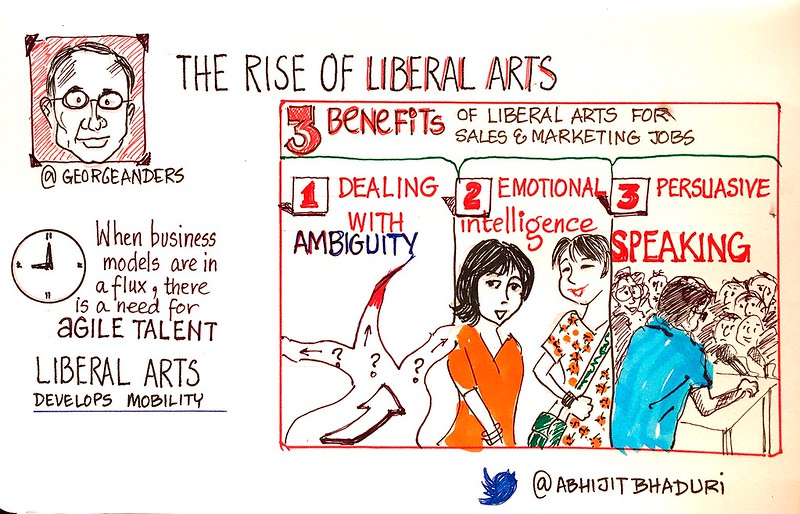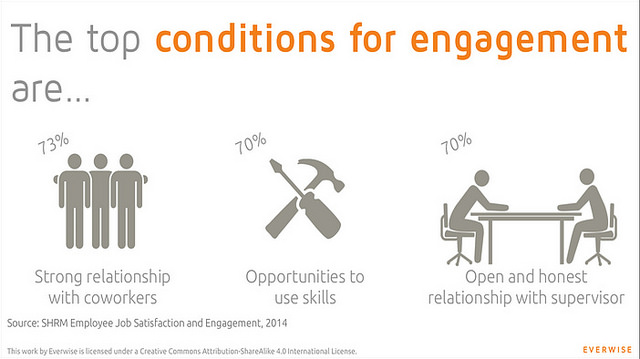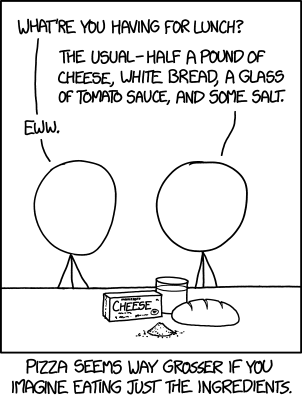|
|
|
Tuesday, October 8th, 2019

Yesterday’s redux was about the importance of liberal arts in a tech-gone-crazy world.
New studies, with hard salary data, bear out this truth.
Yes, tech starting salaries are higher, but that difference goes away relatively quickly.
Not only that, but the tech skills needed today, especially the “hot” skills, didn’t exist 10 years ago, or even three to five years ago, so a tech career requires a willingness to constantly learn the newest whatever that comes along.
That translates to 40 years of racing to keep up with the newly minted competition.
Even staying current won’t assure a good career path, since if you want to go higher more soft skills, such as written and verbal communications, are required.
And in case you are part of my millennial and under audience, written skills don’t refer to proficient texting, while verbal skills mean competently carrying on face-to-face conversations.
Liberal arts can (should) open your mind to other experiences and viewpoints increasing your EQ and SQ, which is critical to getting ahead (and getting along).
There’s another reason liberal arts is even more important now and in the future — AI.
Techies are so enamored with the technology they haven’t given much thought to the fact that AI is best at repetitive functions — like coding.
AI apps like Bayou, DeepCoder, and Commit Assistant automate some tedious parts of coding. They can produce a few lines of code but they can’t yet write programs on their own, nor can they interpret business value and prioritize features.
The stuff AI can’t do isn’t found in a tech education, but liberal arts provides the foundation to do them.
Sometimes a cliché is useful. The bottom line is an education that combines tech skills for the short-term and liberal arts for both short and long-term is the real career winner.
(Note: Although the image above says liberal arts is for sales and marketing, it’s even more crucial for techies.)
Image credit: Abhijit Bhaduri
Posted in Communication, Personal Growth | No Comments »
Monday, July 1st, 2019

Poking through 13+ years of posts I find information that’s as useful now as when it was written.
Golden Oldies is a collection of the most relevant and timeless posts during that time.
Six years since I wrote this and it’s only gotten worse. More time spent on social media, more time spent staring at a screen as the world goes by. But if people don’t reengage soon, the world they knew will no longer exist.
Read other Golden Oldies here.
I had just finished unloading my cart at Home Depot the other day when a woman pulled up with her two young sons; when I offered her my cart she shook her head and kept walking.
There was a time when she might have offered to take the cart, but those times seem a part of the past.
Instead, she kept walking, talked to her sons and answered her cell phone.
Is the world really shrinking or is it just a narrowing of interactions and less interest in what’s around us in real-time?
The more distracted we become, and the more emphasis we place on speed at the expense of depth, the less likely and able we are to care.
Everyone wants his parent’s, or friend’s, or partner’s undivided attention — even if many of us, especially children, are getting used to far less. Simone Weil wrote, “Attention is the rarest and purest form of generosity.”
Each step “forward” has made it easier, just a little, to avoid the emotional work of being present, to convey information rather than humanity.
As usual, I am out of step.
I take back the carts, function beautifully sans cell/smartphone, pay attention to the humans in my orbit and love real-world interactions.
Digging in the dirt, conversation and reading (mostly cozy mystery fiction) are my favorite “time wasters;” no Facebook, Twitter or Candy Crush (my sister’s addiction).
I prefer to be connected to a few in the real world than connected to dozens (hundreds?) in the cyber world.
In short, I want to continue to pay attention and be present for whatever time I have left on this planet, whether decades or days.
Flickr image credit: Enzo Varriale
Posted in Culture, Personal Growth | No Comments »
Thursday, June 14th, 2018

I am in Chicago this week for a mini conference and learned a few things about the importance of attention to detail and preparation.
When my team and I arrived to set up our booth the first thing we learned is we had not paid attention to the details. We had not completed a step in our registration to have our badge scanner work. Initially I thought this would be an issue, but when I had valuable conversations with people on the floor I started asking them to write down their info in my notebook. The result was actual eye contact while speaking and getting a sense of the problem in their own words. Crisis averted but a rookie mistake.
During the course of the conference it was clear that the person in charge of setting up the event is a rockstar. She worked long hours, was dedicated to her role and was literally running around to get things done the day of. The venue was amazing, the speakers fresh and the food was on time.
However, about mid way through the morning the unexpected happened. The power went out.
Power outages and tech events typically do not mix well. As the information became available we leaned that it was not just the venue, but a few city blocks that were without power.
I’m not sure this event was in any contingency plan, but adjustments were made right away. The guest speaker lost his slides, but was able to speak from memory without a microphone. The attendees were forced to look up from laptops without WiFi and have true conversations. And the windows were opened to allow fresh air with the AC out.
The power ended up being out for 2 plus hours and it was interesting to see how people adjusted. The end result though was a memorable experience that led to some positive reviews from attendees. They appreciated that we could not control the power, liked the venue and enjoyed the conversations. Perhaps we can repeat the process next year.
Image credit: Miriam Delirium
Posted in Personal Growth, Ryan's Journal | No Comments »
Wednesday, January 10th, 2018

I’ve written a lot on the both the why and how of face-to-face communications, so today will be a short post, with links to previous content.
Do you wonder why 69% of managers aren’t comfortable talking with their team?
Perhaps it’s because they aren’t comfortable talking period.
What’s going on? What happened to verbal communications a la conversation?
It’s not just tech, although tech has made it much worse.
Modern managers have avoided discussions with employees, especially about performance issues.
Before computers they tried to manage by memo; post computer by email and most recently by texting. None of them work.
Problem 1: screens kill empathy and empathy underlies all positive human interactions.
Solution: Turn off your screens. And if you believe everything will fall apart if you are unavailable for 20 minutes here and 40 minutes there each day then your organization is in far worse shape than you realize.
Problem 2: AMS; it stands for assumption, manipulation, self-fulfilling prophesy.
Solution: Build internal awareness of your AMS (we all do it), then work to control it. Don’t try to completely eradicate it; it’s a waste of effort.
Problem 3: Two-way street.
Solution: Learn to listen, not just hear. Active listening is at least 50%, often more; if you talk, but don’t listen it isn’t a conversation.
Good communicating is like writing good code.
You can study it forever, but eventually you need to get out there and just do it.
And the more proficient you become the more you will enjoy it.
Scary? Sure.
But not nearly as scary as stunting your future, both at work and in your wider world.
Image credit: Flickinpicks
Posted in Communication, Motivation, Personal Growth, Retention | No Comments »
Tuesday, January 9th, 2018

This is one of the worst stats about managers I’ve come across recently.
… 69% of respondents [US managers] said that they found “communicating in general” to be the hardest part about communicating with employees.
If you are one of that 69% then you should consider the flip side of the equation — employees.
The percentage of US managers who say they don’t like talking with employees mirrors the 67% of US workers who say they’re not engaged at work. That figure comes from the most recent Gallup survey of the US workplace, the company’s annual in-depth report on more than 31 million workers across US industries.
Why?
…one of the primary things employees say they need to feel engaged and productive at work is regular, meaningful communication with their managers.
It’s black and white; cause and effect.
It’s a simple bottom line.
If you don’t make the effort and learn to be comfortable having face-to-face conversations with your people, then you lose the right to complain about their engagement, motivation, productivity, creativity, and turnover — not to mention damaging your own career path.
As usual, it’s your choice.
Image credit: Get Everwise
Posted in Communication, Motivation, Personal Growth, Retention | No Comments »
Monday, December 18th, 2017
It’s amazing to me, but looking back over more than a decade of writing I find posts with information that is as useful now as when it was written.
Golden Oldies is a collection of what I consider some of the best posts during that time.
It’s that time of the year. No matter what media you prefer you’ll find something about the best stuff gifts for your first apartment, tech gifts, various gift categories at different price points, and on and on. You can also find a myriad of options to give experiences, instead of stuff — if you can afford to give experiences.
Below I’ve described two ways to give something unforgettable, no matter your budget,
Read other Golden Oldies here.
D uring the holiday media gift frenzy it is the truly wise who remember that the best gifts aren’t electronic or screen-dependent. uring the holiday media gift frenzy it is the truly wise who remember that the best gifts aren’t electronic or screen-dependent.
The very best aren’t paid for with money, either, but with a much more precious currency — time.
Time to love.
Time for friendship.
Time to play.
Time to talk and laugh together — F2F
Food cooked and shared together at (someone’s) home.
Not just during the season, but scattered throughout the year like diamonds on a velvet cloth or stars in a clear night sky.
Along with time, the most wonderful gift you can give a child is a love of books — real books.
Real because reading a printed page affects the brain in different and better ways than words on a screen.
Whether your child reads or you read to them start with the books from Lost My Name, which creates personalized books using your child’s name.
Lost My Name — founded in 2012 by Asi Sharabi and Tal Oron — creates customised books based around a child’s name. The books are created and ordered online, then sent out to printing partners around the world. (…) “As a technology company, we’re very proud to be innovating on one of the oldest media formats in the world – the physical book,” said Oron. “We think technology equals possibility. And possibility is the dominant currency in wonderful, nostalgic storytelling, where the book’s job is to inspire children to believe in adventure; that anything can happen if they imagine it. As screens become more and more seductive to children, there is an increasing need to inject more magic into books – to find new ways to spark their imagination.”
Even better are the books by Randall Munroe, former NASA roboticist, who specializes in science humor and whose 2014 book, “What If?: Serious Scientific Answers to Absurd Hypothetical Questions,” became an unexpected mainstream hit.
Munroe believes that anything can be explained simply using normal language and proves it in his new book (which is a good choice for anyone on your gift list).
“Thing Explainer: Complicated Stuff in Simple Words.” The oversized, illustrated book consists of annotated blueprints with deceptively spare language, explaining the mechanics behind concepts like data centers, smartphones, tectonic plates, nuclear reactors and the electromagnetic spectrum. In his explanations, Mr. Munroe avoided technical jargon and limited himself to the 1,000 most commonly used words in the English language. This barred him from using words like helium and uranium, a challenge when describing how a rocket ship or reactor works.
For book links and great comics (sample above; chosen for enabling holiday restraint) visit Munroe’s site.
Books are good for adults, too. There are great sites beyond Amazon that offer critiques of books that run the business gamut from being a better boss to upping your game wherever you are in your career.
Another great thing about real books is what you can do when you are done reading them.
- Some you’ll want to keep for your own library;
- some you’ll share with friends, colleagues and those you mentor; and
- the rest can be donated to your local library.
Happy reading! Happy discovery!!
Image credit: Randall Munroe
Posted in Personal Growth | No Comments »
Thursday, August 10th, 2017

Have you ever had one of those days where you just can’t seem to get it together?
You drink your coffee, go on your run, or perhaps your moment of zen. Yet that doesn’t get you out of your rut. What do you do about it?
I am in a stage of life where I am building.
I am building my sales practice, building my family (up to five now), and building my wealth. I have found that those all keep me busy and I have little time for me. When I compare myself to my friends, though, they are in similar circumstances.
The ebb and flow of emotions is normal. Low points happen and should not be feared. However, if we allow ourselves to dwell too long, it can become more than a rut, it can be a lifestyle.
I have a new little girl at home and she is amazing. She also is a night owl and I have found that sleep deprivation and feeling down are directly correlated. My wife and I are walking around in a fog and I am not at my best.
I have started to become aware of this in the past week and have actively worked out ways to overcome it.
Currently my little one likes to wake around 5:30 in the morning. I have found if I just get up to go for a run I get the added bonus of watching the sun rise. That’s an amazing feeling.
I have also found that she likes to cry a bit so we stay up rocking her. This has led to my wife and I having genuine conversations because our phones aren’t attached to our faces. This has also been amazing as I actually like my wife. (To be clear I love her as well).
I say all of this because it’s on my mind. I know I am a bit low and I know others are too on occasion.
Ultimately it is our choice on how we proceed.
How will you proceed?
Image credit: Larry Jacobsen
Posted in Personal Growth, Ryan's Journal | No Comments »
Tuesday, March 21st, 2017
 Why is it that the most difficult part of management, i.e., people management, constantly moves backwards? Why is it that the most difficult part of management, i.e., people management, constantly moves backwards?
Managers from the Greatest Generation tried to manage by memo.
That lasted until the 1970s when Boomer and Gen X managers took a giant step backwards and started trying to manage by email.
Millennials have taken an even larger step in that direction by trying to manage by text and have swept many of the previous contingents along with them.
Granted, people at all levels often look for and find ways, frequently turning to available technology, to avoid, or at least minimize, the most frustrating and difficult parts of their jobs.
However, that doesn’t work when the frustrating part is 90% of the job.
Every time this comes up I find myself quoting something Terry Dial said to me decades ago.
“People are 90% of our costs as well as the key to customer service and satisfaction. The only thing that should take priority over hiring a new employee is keeping a current one.”
Wally Bock puts it this way (and offers excellent advice on how to do it.)
In the Marines, I learned that when you’re responsible for a group, you have two jobs. One of them is to accomplish the mission. The other is to take care of the people.
I personally guarantee that you won’t accomplish the former if you ignore the latter.
You cannot “care for your people” by email or text — it requires face time.
It requires one-on-one conversations — wherever they take place — and not just about performance.
Conversations need to be human, that means family, hobbies, food, sports, etc.
Face-to-face humanizing contact is critical for teams, too, whether they are in a different office around the block or around the globe.
As Valerie Berset-Price, founder of Professional Passport says,
“Building trust is a multisensory experience,” she says. “Only when people are physically present together can they use all of their senses” to establish that needed trust. Without a bond, conflict or disengagement can more easily arise and is more difficult to resolve.
So whether you consider yourself a manager, a leader, a boss, or just a plain working stiff honing your in-person communication skills will not only improve your career opportunities, but also all parts of your life.
PS I just saw this article on IBM’s move to have teams in-person face-to-face.
Image credit: gorfor
Posted in Communication, Ducks In A Row, Motivation, Personal Growth, Retention | No Comments »
Wednesday, July 20th, 2016
You may find this surprising, but the phones you texted to arrange getting together for dinner are not sentient.
In reality, they are the property of sentient beings whose face2face company you enjoy (or did at one time).
Since you planned a meal with them, I’ll assume you still do and suggest you follow the advice below.

Buon appetito or, if you prefer, bon apetite.
Image credit: Anonymous email
Posted in Communication, Miki's Rules to Live by, Personal Growth | No Comments »
Wednesday, December 16th, 2015

During the holiday media gift frenzy it is the truly wise who remember that the best gifts aren’t electronic or screen-dependent.
The very best aren’t paid for with money, either, but with a much more precious currency — time.
Time to love.
Time for friendship.
Time to play.
Time to talk and laugh together — F2F
Food cooked and shared together at (someone’s) home.
Not just during the season, but scattered throughout the year like diamonds on a velvet cloth or stars in a clear night sky.
Along with time, the most wonderful gift you can give a child is a love of books — real books.
Real because reading a printed page affects the brain in different and better ways than words on a screen.
Whether your child reads or you read to them start with the books from Lost My Name, which creates personalized books using your child’s name.
Lost My Name — founded in 2012 by Asi Sharabi and Tal Oron — creates customised books based around a child’s name. The books are created and ordered online, then sent out to printing partners around the world. (…) “As a technology company, we’re very proud to be innovating on one of the oldest media formats in the world – the physical book,” said Oron. “We think technology equals possibility. And possibility is the dominant currency in wonderful, nostalgic storytelling, where the book’s job is to inspire children to believe in adventure; that anything can happen if they imagine it. As screens become more and more seductive to children, there is an increasing need to inject more magic into books – to find new ways to spark their imagination.”
Even better are the books by Randall Munroe, former NASA roboticist, who specializes in science humor and whose 2014 book, “What If?: Serious Scientific Answers to Absurd Hypothetical Questions,” became an unexpected mainstream hit.
Munroe believes that anything can be explained simply using normal language and proves it in his new book (which is a good choice for anyone on your gift list).
“Thing Explainer: Complicated Stuff in Simple Words.” The oversized, illustrated book consists of annotated blueprints with deceptively spare language, explaining the mechanics behind concepts like data centers, smartphones, tectonic plates, nuclear reactors and the electromagnetic spectrum. In his explanations, Mr. Munroe avoided technical jargon and limited himself to the 1,000 most commonly used words in the English language. This barred him from using words like helium and uranium, a challenge when describing how a rocket ship or reactor works.
For book links and great comics (sample above; chosen for enabling holiday restraint) visit Munroe’s site.
Books are good for adults, too. Check out this month’s Leadership Development Carnival for critiques of books that run the business gamut from being a better boss to upping your game wherever you are in your career.
Another great thing about real books is what you can do when you are done reading them.
- Some you’ll want to keep for your own library;
- some you’ll share with friends, colleagues and those you mentor; and
- the rest can be donated to your local library.
Happy reading! Happy discovery!!
Image credit: Randall Munroe
Posted in Personal Growth | 1 Comment »
|
 Subscribe to
Subscribe to
MAPping Company Success
About Miki 
Clarify your exec summary, website, etc.
Have a quick question or just want to chat? Feel free to write or call me at 360.335.8054
The 12 Ingredients of a Fillable Req
CheatSheet for InterviewERS
CheatSheet for InterviewEEs™
Give your mind a rest. Here are 4 quick ways to get rid of kinks, break a logjam or juice your creativity!
Creative mousing
Bubblewrap!
Animal innovation
Brain teaser
The latest disaster is here at home; donate to the East Coast recovery efforts now!
Text REDCROSS to 90999 to make a $10 donation or call 00.733.2767. $10 really really does make a difference and you'll never miss it.
And always donate what you can whenever you can
The following accept cash and in-kind donations: Doctors Without Borders, UNICEF, Red Cross, World Food Program, Save the Children
*/
?>About Miki
About KG
Clarify your exec summary, website, marketing collateral, etc.
Have a question or just want to chat @ no cost? Feel free to write
Download useful assistance now.
Entrepreneurs face difficulties that are hard for most people to imagine, let alone understand. You can find anonymous help and connections that do understand at 7 cups of tea.
Crises never end.
$10 really does make a difference and you’ll never miss it,
while $10 a month has exponential power.
Always donate what you can whenever you can.
The following accept cash and in-kind donations:
|















